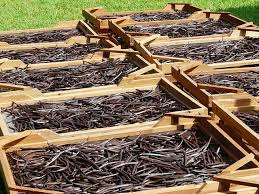 The zig-zag vine, also known as "acid drop vine"and "wild banana,"
The zig-zag vine, also known as "acid drop vine"and "wild banana," has a curious growth pattern. In the wild, it starts at the bottom of a host tree and zig-zags up the trunk until it reaches the sunlight at the top.
In a controlled setting, the zig-zag vine makes a nice evergreen shrub, growing from three to twenty feet high, but in the wild, the sky is the limit.
 |
| Zig-zag fruit is the size of a peanut. |
The Zig-zag vine is native to the rain forests of eastern Australia. It also grows in New Guinea, Malaysia, Thailand, the Philippines, Borneo, and Indonesia (Malesia).
 |
| Zig-zag vine flower |
"Orange sherbet anyone?"
 Zig-zag Books
Zig-zag Books--Agent Zigzag: A True Story of Nazi Espionage, Love, and Betrayal
by Ben Macintyre (2009)

--Zig Zag: The Surprising Path to Greater Creativity by Keith Sawyer (2013)
 --Zigzag by Ellen Wittlinger (2012) (fiction)
--Zigzag by Ellen Wittlinger (2012) (fiction)--Zigzag: The Incredible Wartime Exploits of Double Agent Eddie Chapman by Nicholas Booth (2007)
 --The Zigzag Principle: The Goal Setting Strategy That Will Revolutionize Your Business and Your Life by Rich Christiansen (2011)
--The Zigzag Principle: The Goal Setting Strategy That Will Revolutionize Your Business and Your Life by Rich Christiansen (2011)--Inga's Zigzags
by Vica Miller (2014) (fiction)

--Architects Make Zigzags: Looking at Architecture from A to Z
by Diane Maddex (1986)
--Zigzag (2005) (picture book)
by Robert San Souci
Zig-zag Movies

--The Zigzag Kid (2012)
(Nono wants to be like his father, the best police inspector in the world) (Adventure, family)
--Zig Zag (2002) (An autistic 15-year-old boy steals money from his boss to pay rent for his abusive father) (drama)

Zig Zag Story (1983) The lives of three parisians, a color-blind painter, a radio show host, and a perverted photographer interwine hilariously. (Comedy, Drama)
Zig-zag Song
And so....ooo, Zig-zagging
We did it everyone! Take a big BIG BOW!!!
http://fruitandnuttrees.com/acid-drop-vine-zig-zag-vine; http://www.drytropics.org.au/ArticlesSpeciesInfo.htm
http://keys.trin.org.au/key-server/data/0e0f0504-0103-430d-8004-060d07080d04/media/Html/taxon/Melodorum_leichhardtii.htm
http://www.brisrain.webcentral.com.au/01_cms/details_pop.asp?ID=88
http://toowoombaplants2008.blogspot.com/2010_02_01_archive.html
http://en.wikipedia.org/wiki/Melodorum_leichhardtii
http://en.wikipedia.org/wiki/Melodorum_leichhardtii
Sharon M. Himsl
Writer/Author. Blogging since 2011.
Published with Evernight Teen:
~~The Shells of Mersing









































